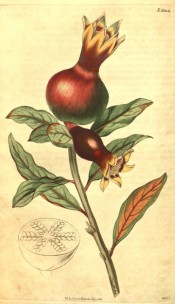Punica granatum L.
Frost hardy, upright, sometimes spiny, shrub or small tree with opposite, narrowly-oblong leaves, to 8cm long, and clusters of up to 5 funnel-shaped, bright orange-red flowers in summer, followed by spherical yellow-brown, edible fruit, to 12cm across. To 6m. It will form a dense hedge under appropriate conditions. [RHSE, Hortus, Hilliers’].
Horticultural & Botanical History
‘The Pomegranate Tree is ornamental, even in foliage, and sufficiently hardy, not only to bear the cold of our climate, but, if placed against a warm wall, to produce flowers freely; and, in favourable seasons, will even bring its beautiful fruit to a certain degree of maturity. It is probably because such situations are usually in request for fruit for the table, that this tree is not more generally cultivated in this country. The double-flowered variety produces no fruit; but its blossoms being more shewy, is mostly preferred, as fruit is hardly to be expected, except in very favourable seasons, and is, in no case, fit for eating; it is nevertheless pleasing to the eye. In the countries where the Pomegranate is cultivated for use, three kinds of fruit are particularly mentioned; the sweet, the acid, and the vinous.
Native of Spain, Italy, Barbary, Persia, Japan, and Cochinchina, and cultivated in the East and West-Indies. According to Turner, it was to be seen in Sion Garden as long ago as 1548.
Should be planted in a warm situation; and, according to Miller, in a strong rich soil; but is said in its native countes to affect a poor chalky soil. Propagated by layers which should be laid down in the sprng, and in a year’s time will be suffcent rooted to be removed.
The flower of the double variety are astringent, and were formerly used in medicine and kept in the shops, under the name of Balaustins. The rind of the fruit is more powerfully astringent and is said to be used in Persia, in dying leather black. Bacon recommends wine made of the sweet Pomegranates; or, where that cannot be had, the juice, with a little sugar and lemon-peel and three or four cloves, to be taken every morning, from February to the end of April as good for the liver.’ [BM t.1832/1816].
History at Camden Park
Listed in all published catalogues [T.785/1843]. A number of mature trees survive in the long-abandoned part of the gardens known as The Clearings, principal site of operations of the Camden Park nursery in the mid-19th century. Pomegrates, red and white, were also listed under Plants Bearing Fruit in all published catalogues.
Notes
Published Mar 05, 2010 - 03:10 PM | Last updated Jul 25, 2010 - 05:03 PM
| Family | Lythraceae |
|---|---|
| Category | |
| Region of origin | Southern Europe to Himalayas |
| Synonyms | |
| Common Name | Pomegranate |
| Name in the Camden Park Record |
Punica granatum - Pomegranate |
| Confidence level | high |
